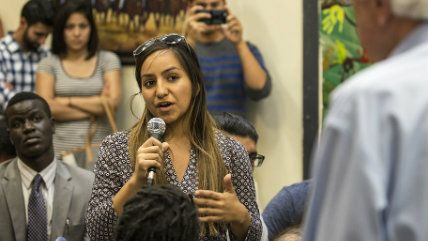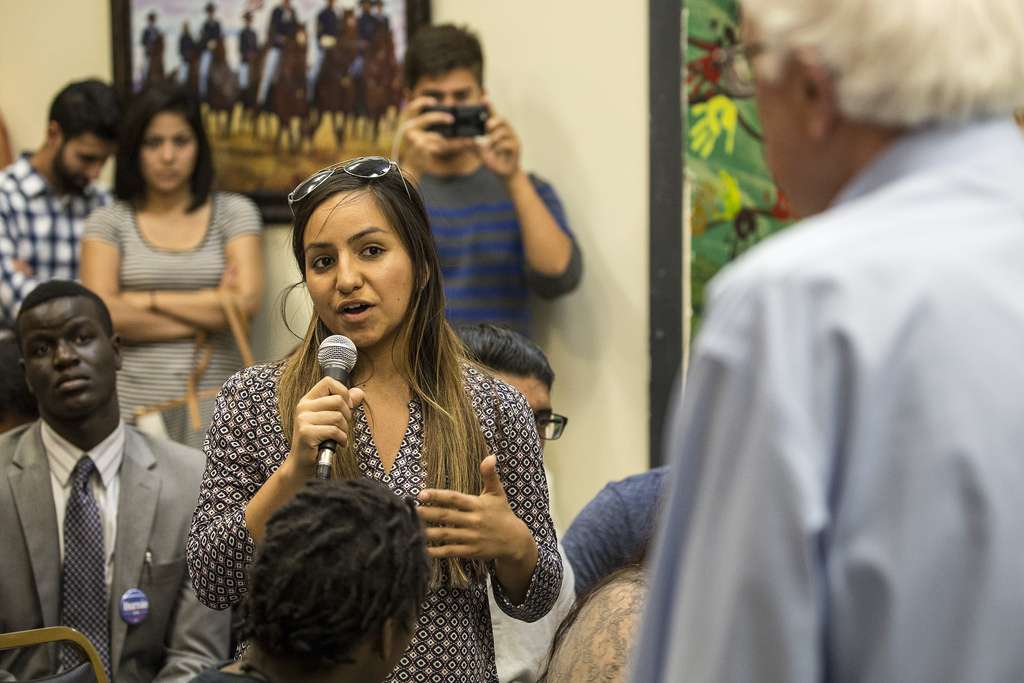#BernieBrosSoWhite? Real Gap in Sanders Support Not from Gender but Race, Ethnicity
Forget the supposed gender divide in Bernie Sanders support. The real divide over Sanders lies between white and non-white Democrats.


The youth appeal of septuagenarian Sen. Bernie Sanders has been the big story of the Democratic primary so far. But is this another instance of pollsters and pundits overlooking minority millennials? Several recent polls show that among young non-white Democrats, Hillary Clinton is still the top candidate.
Put another way, it's simply not true that "Sanders dominates among younger voters in nearly every racial and gender category," as NBC reported a few weeks ago.
In a January USA Today/Rock the Vote poll, for instance, Sanders was the preferred liberal candidate among millennial Democrats and independents overall, leading with 46 percent to Clinton's 35 percent. Among millennials of color, however, Sanders beat Clinton by a mere one point (42 percent to 41 percent).
In a national poll conducted January 19-24 by the Beck Research for the American Federation for Children, Democratic millennials as a whole were again drawn strongly to Sanders (64 percent to 29 percent). But among young Hispanic Democrats, Clinton led 52 percent to Sanders' 38 percent.
And in the latest NBC News|SurveyMonkey poll—conducted online from Feb 8-14—Sanders was the top candidate for 47 percent of white Democrats, but just 20 percent of black Democrats chose Sanders, with 75 percent supporting Clinton. This racial divide held true for millennials, with 64 percent of young black Democrats in Clinton's camp, while just 25 percent favored Sanders. Among young white Democrats nearly the exact opposite was true, with Sanders the top choice of 75 percent and Clinton just 22 percent.
While America may have "millennial fatigue," the generation is just starting to reach its peak political power. Now that nearly all millennials have reached voting age (by the widest parameters, the last of this cohort were born in the year 2000), they stand to rival boomers for political impact in the upcoming election. The current crop of 18- to 35-year-olds will make up 31 percent of all eligible U.S. voters in 2016, the same percentage of the electorate populated by boomers. (Gen X represents a quarter of eligible voters this year and pre-boomers 13 percent.)
Because young voters tend to turn out in lower numbers than the olds, boomers are still likely to outpace millennials at the 2016 ballot box. But any candidate who can harness the millennial vote still stands to gain significantly. And among millennial voters, Latinos are a big force to reckon with.* They make up about 44 percent of all eligible Latino voters in America, and the largest proportion of millennial voters aside from white non-Hispanics.
About 21 percent of voting-age millennials are Latino, 57 percent are (non-Hispanic) white, 13 percent are (non-Hispanic) black, and six percent are Asian.
Yet the electoral influence of Latino millennials may be minimized by their concentration in a few geographic locales. While Latinos do make up a sizable portion of voters in some key areas—including Florida (18 percent), Nevada (17 percent), Colorado (14.5 percent), and Illinois (10.5 percent)—more than half of all eligible Latino voters can currently be found in just three states: California, Texas, and New York.
Low voter turnout may also dampen Latino political impact. In the 2012 elections, Latinos had significantly lower turnout than whites or blacks, at 48 percent versus 64 and 66.6 percent, respectively.
While young Latino turnout may be low, however—and white youth turnout has been flat—young black voters have been hitting the polls in increasing numbers (though there is some skepticism among black millennials that this will continue). Black voters as a whole, including black millennials, tend to lean overwhelmingly Democrat. And among these black Democrats, Clinton has a significant edge.
A national survey conducted by Public Policy Polling (PPP) at the beginning of February found Clinton besting Sanders among Democrat-leaning voters as a whole, with 53 percent support to his 32 percent. But this difference was especially stark among black voters, with whom Clinton's support sprung to 82 percent. She was also rated favorably by 79 percent of black voters, with just 9 percent rating her unfavorably, while only 27 percent of black voters rated Sanders favorably and 23 viewed him in a negative light.
"Bernie Sanders continues to make in roads with most segments of the Democratic electorate," said Dean Debnam, president of PPP. "But his continued struggles with African Americans could give him a lot of trouble when the contest moves beyond New Hampshire to states where there's racial diversity."
Indeed, Sanders seems to be in for a rough patch ahead in the Southern and Mid-Atlantic primaries.
In South Carolina, which will hold its primary on February 27, PPP this week found Clinton leading 55 percent to 34 percent over Sanders among all likely Democra#mce_temp_url#tic-primary voters, propelled largely by support from the black electorate. In fact, Clinton and Sanders were tied among white Democrats in South Carolina. But blacks make up more than half of likely Democratic voters, and they prefer Clinton by 40 percentage points (63 percent to 23 percent).
Another poll of South Carolina voters, this one conducted from February 10-12, also put Clinton ahead overall, with 59 percent of the likely Democratic vote compared to Sanders' 40 percent. White Democrats in this poll preferred Sanders by nearly 30 percentage points, but blacks broke for Hillary 73 percent to 26 percent.
In North Carolina, a PPP poll from mid-January found that Clinton also enjoys hefty support from black Democrats, who make up about a third of the primary electorate, in the Tar Heel state. Just 12 percent of black Democrats preferred Sanders, while 77 percent said they would vote for Clinton. Meanwhile, 81 percent of black Democrats said they have a favorable opinion of Clinton, while only 43 percent felt favorably about Sanders.
The former secretary of state also outshines Sanders in Georgia, which will hold its primary on Super Tuesday (March 1), and Maryland, which votes in April. In Maryland, black Democrats prefered Clinton 10-to-1 over Sanders when polled in January, while white Democrats preferred Sanders by a little less than 2-to-1. Overall, 40 percent of Maryland Democrats said they would vote for Clinton, 27 percent for Sanders, and 5 percent for Martin O'Malley, while 28 percent were undecided.
In Georgia—where blacks make up more than half of the electorate—a poll from Atlanta's Channel 2 Action News found Clinton favored by 63 percent of likely Democratic voters, with just 21.5 supporting Sanders and 15 percent undecided. "Clinton far and away locks up the African-American vote," the station noted, with nearly 77 percent favoring Clinton and just 11 percent choosing Sanders. Among white Georgia Democrats, Clinton only led by about 15 percentage points.
Little presidential-polling data exists on Asian-Americans specifically. This is a group that has tended to lean Democrat for the past several decades, although nearly half of Asian-Americans now describe themselves as politically independent and, in 2014, Republicans won the overall Asian vote by one percentage point nationwide.
Both the Republican and Democratic National Committees have been making plays to court Asian-American voters recently. Asians are the fastest-growing racial group in the United States, but also the least likely to vote. They accounted for just 3 percent of the electorate in 2012, and are expected to make up 4 percent of the electorate this year. Asian-American political organizers say they're currently focusing efforts on Nevada, where 8.3 percent of the total population and 7.3 percent of eligible voters identify as Asian or Pacific Islander. The most recent polls show Sanders and Clinton tied among likely Democratic voters there.
* This post previously stated that Hispanics account for 44 percent of all eligible Millennial voters when it's actually that millennials account for 44 percent of all eligible Hispanic voters.


Show Comments (125)